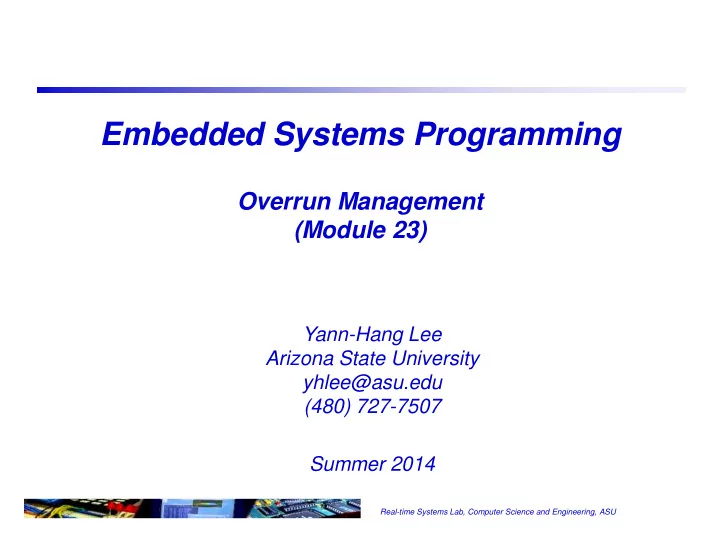

Embedded Systems Programming Overrun Management (Module 23) Yann-Hang Lee Arizona State University yhlee@asu.edu (480) 727-7507 Summer 2014 Real-time Systems Lab, Computer Science and Engineering, ASU
Overrun Management Imprecise computation trades off precision for timeliness during a transient overload. A task consists of two or more logical parts: a mandatory part and at least one optional part. The mandatory part must meet deadline constraint The optional part only affect the quality of result Implementation Synchronous approach: polling after each iteration of optional computation Separate tasks for mandatory and for optional parts The optional task (OT) sends results back to the mandatory task (MT) When running out the allocated execution time, MT puts out results and kill OT Asynchronous transfer of control (Exception) 1 Real-time Systems Lab, Computer Science and Engineering, ASU
Asynchronous Transfer of Control Communication between threads may be either synchronous or asynchronous. Asynchronous communication Resumption (through signals and signal handling) model and termination model If some change in the system environment needs immediate attention Time out on a computation Terminate a thread Terminate one loop of computation A controversial issue Difficult to write correct code Release resources Performance penalty RTSJ_set2_ 2 2 Real-time Systems Lab, Computer Science and Engineering, ASU
C and C++ Exceptions C does not define any exception handling facilities C++ exception: try, throw, and catch Cannot throw in signal handler To implement ATC model, it is necessary to save the status of a program's registers etc. on entry to an exception domain and then restore them if an exception occurs. The POSIX facilities of setjmp and longjmp can be used for this purpose Finalization: done by the programmer Language support of ATC: Ada and RTSJ 3 Real-time Systems Lab, Computer Science and Engineering, ASU
C++ exception throw and catch The function will throw DivideByZero as an exception caught by an exception-handling catch statement that catches exceptions of type int. The necessary construction is a try catch system. So, a program that checks for exceptions and may have exceptions thrown must be enclosed in a try block. (http://www.cprogramming.com/tutorial/exceptions.html) 4 4 Real-time Systems Lab, Computer Science and Engineering, ASU
setjmp and longjmp setjump saves the program status and returns a 0 longjmp restores the program status and results in the program abandoning its current execution and restarting from the position where setjump was called this time setjump returns the values passed by longjmp See the example in the next slide Program status is saved in a global variable jumper of type jum_buf . One may need different exception handlers in different functions. So how will SigHandler() know which jumper to use? 5 Real-time Systems Lab, Computer Science and Engineering, ASU
An Exception Handling in C /* The simplest error handling based on setjmp() and longjmp() */ jmp_buf jumper; void sigHandler() { if (overrun) longjmp(jumper, -1); /* can't divide by 0 */ return; } void SomeTask (void) { int result; if (setjmp(jumper) == 0) { result = SomeComputation; /* continue working and save result */ } else put_out(result); /*overrun, send out the saved result */ } 6 Real-time Systems Lab, Computer Science and Engineering, ASU
Task Preemption Preemptivity: suspend the executing job and switch to the other one should a job (or a portion of job) be preemptable context switch: save the current process status (PC, registers, etc.) and initiate a ready job transmit a UDP package, write a block of data to disk, a busy waiting loop Preemptivity of resources: concurrent use of resources or critical section lock, semaphore, disable interrupts How can a context switch be wake-up waiting ready triggered? Assume you want to preempt an executing job -- why suspended blocked dispatched a higher priority job arrives executing run out the time quantum 7 Real-time Systems Lab, Computer Science and Engineering, ASU
Recommend
More recommend